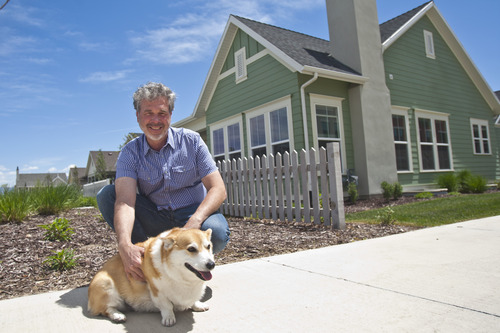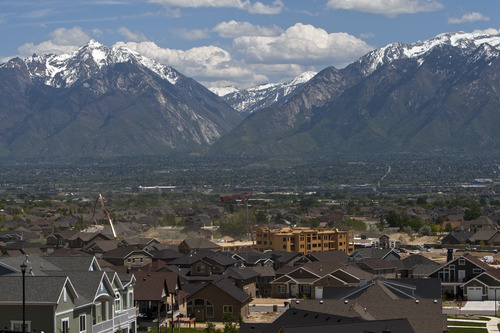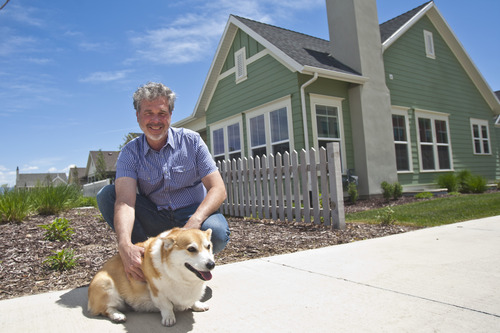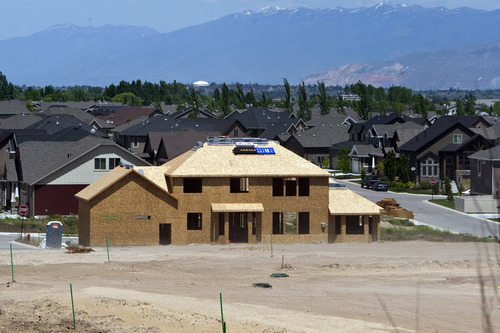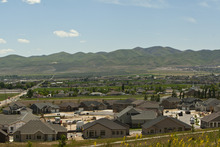This is an archived article that was published on sltrib.com in 2013, and information in the article may be outdated. It is provided only for personal research purposes and may not be reprinted.
South Jordan • As Doug Monroe explains why he relocated to Utah's fastest growing city, cement trucks rumble by on their way to yet another new housing development.
"It's going crazy out here," said Monroe, 57, who moved to South Jordan's Daybreak subdivision from Pleasant View in Weber County eight months ago.
"We loved the house but my wife wanted to be closer to the city," Monroe said of leaving Pleasant View. After looking in Salt Lake City's Sugar House neighborhood, he and spouse Rhea Gavry opted for a gated community in Daybreak, attracted by South Jordan's low crime rates, lack of traffic congestion and easy access to mass transit.
Others seem to agree. South Jordan's population grew at the second fastest rate among all large cities in the country, according U.S. Census Bureau figures released Thursday.
The city in southwest Salt Lake County grew by 4.9 percent over the one-year period ending July 1, 2012, to a total of 55,934 residents. Only the Texas city of San Marcos, between Austin and San Antonio, had a higher one-year growth rate across the U.S.
Measured over a two-year period ending July 1, 2012, South Jordan's growth rate was even higher, at 10.9 percent.
"I knew we were growing fast but that's kind of astonishing," city spokesman Chip Dawson said.
Other rapidly growing cities over the same time period, according to the U.S. Census, include Lehi, West Jordan, St. George, Orem, Taylorsville, West Valley City and Sandy.
Salt Lake City grew by 1.5 percent during those two years, to a 2012 population of 189,314, the newly released numbers show.
Signs of South Jordan's growth are not hard to find.
It is the only city worldwide with two Mormon temples, the Jordan River Temple and the Oquirrh Mountain Temple. For weekend openings of major films, The District Megaplex Theatres in South Jordan will occasionally place among top theaters nationally for gross receipts.
Many factors appear to be driving the trend, which has built steadily since the mid-1990s. One is housing. As cities at Salt Lake County's north end become increasingly built out, South Jordan still has plenty of room.
In the first three months of 2013, one in four of all residential building permits issued countywide were for new homes in South Jordan. More telling, the city accounted for 28 percent of the total value of residential construction in the county between January and March.
"We've continued to enjoy in South Jordan a very positive influx of high-income residents," Mayor Scott Osborne said. Those moving to South Jordan tend to be well-educated professionals with larger than average families, he said.
Osborne said the city's average home value is about $380,000 these days. "It's not an especially inexpensive place to build and buy," he noted.
With the availability of large lots, recreational opportunities and ready access to public transportation such as the Utah Transit Authority's TRAX and FrontRunner services, South Jordan has become trendy, city economic development director Brian Preece said.
"South Jordan has become the ZIP code that people want to live in," Preece said. "It's the east side of the west side, so to speak."
The city also has benefited from wise planning and zoning, Preece noted.
South Jordan is almost the exact size and shape as the island of Manhattan. Those long, thin contours don't lend themselves to traditional growth that expands out from one city center, said Preece. Instead, South Jordan has encouraged development of separate retail and business corridors along the north-south arteries of Interstate 15, Redwood Road and Bangerter Highway.
Those corridors draw commerce. The city added 117 new businesses last year, bringing the count of brick-and-mortar businesses in South Jordan to 1,750, the mayor said. And in turn, that's meant local job growth, helping the city evolve away from its image as a bedroom community where residents commute to other cities to work.
South Jordan also has a flexible approach to development projects, both commercial and residential, officials say. The city built a reputation as "a place the developers knew was a welcoming environment," Preece said. "And without the developers, no city gets built." Fastest growing large Utah cities*, 2010-2012
Rank among U.S. cities City Population estimate, April 1, 2010 Population estimate, July 1, 2012 Population gain % Change
3 South Jordan 50,418 55,934 5,516 10.9
9 Lehi 47,460 51,173 3,713 7.8
80 West Jordan 103,712 108,383 4,671 4.5
145 St. George 72,903 75,561 2,658 3.6
222 Provo 112,488 115,919 3,431 3.1
269 Orem 88,328 90,749 2,421 2.7
279 Taylorsville 58,652 60,227 1,575 2.7
330 West Valley City 129,480 132,434 2,954 2.3
356 Sandy 87,499 89,344 1,845 2.1
373 Layton 67,311 68,677 1,366 2.0
457 Salt Lake City 186,443 189,314 2,871 1.5
515 Ogden 82,825 83,793 968 1.2
* Large cities are those with a population of at least 50,000.
Source: U.S. Census Bureau 15 fastest-growing large U.S. cities*
July 1, 2011 to July 1, 2012
Rank City/Town State % Increase 2012 total population
1 San Marcos Texas 4.91 50,001
2 South Jordan Utah 4.87 55,934
3 Midland Texas 4.87 119,385
4 Cedar Park Texas 4.67 57,957
5 Clarksville Tennessee 4.43 142,519
6 Alpharetta Georgia 4.37 61,981
7 Georgetown Texas 4.21 52,303
8 Irvine California 4.21 229,985
9 Buckeye Arizona 4.14 54,542
10 Conroe Texas 4.01 61,533
11 McKinney Texas 3.95 143,223
12 Frisco Texas 3.92 128,176
13 Odessa Texas 3.83 106,102
14 Auburn Alabama 3.71 56,908
15 Manhattan Kansas 3.71 56,069
* Large cities are those with a population of at least 50,000.
Source: U.S. Census Bureau


